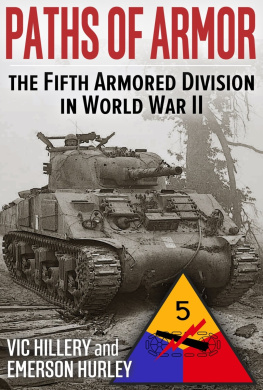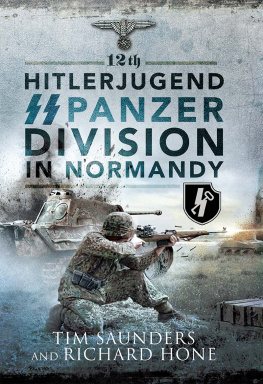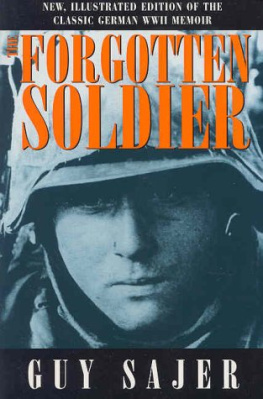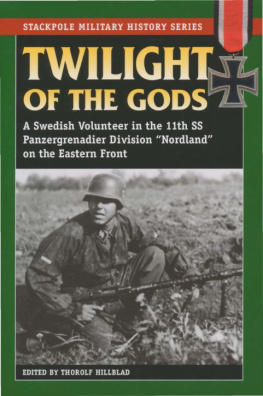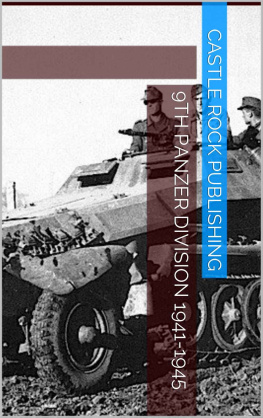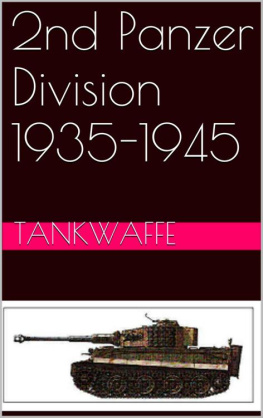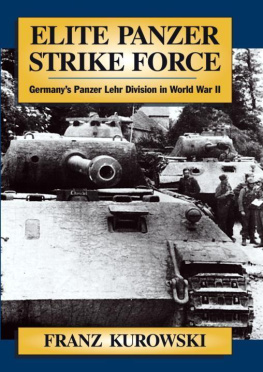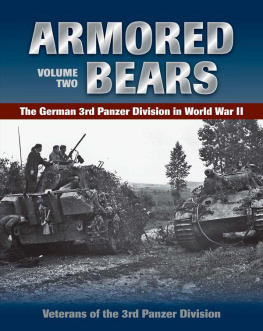A. Harding Ganz - Ghost Division: The 11th Gespenster Panzer Division and the German Armored Force in World War II
Here you can read online A. Harding Ganz - Ghost Division: The 11th Gespenster Panzer Division and the German Armored Force in World War II full text of the book (entire story) in english for free. Download pdf and epub, get meaning, cover and reviews about this ebook. year: 2016, publisher: Stackpole Books, genre: Non-fiction. Description of the work, (preface) as well as reviews are available. Best literature library LitArk.com created for fans of good reading and offers a wide selection of genres:
Romance novel
Science fiction
Adventure
Detective
Science
History
Home and family
Prose
Art
Politics
Computer
Non-fiction
Religion
Business
Children
Humor
Choose a favorite category and find really read worthwhile books. Enjoy immersion in the world of imagination, feel the emotions of the characters or learn something new for yourself, make an fascinating discovery.

- Book:Ghost Division: The 11th Gespenster Panzer Division and the German Armored Force in World War II
- Author:
- Publisher:Stackpole Books
- Genre:
- Year:2016
- Rating:3 / 5
- Favourites:Add to favourites
- Your mark:
- 60
- 1
- 2
- 3
- 4
- 5
Ghost Division: The 11th Gespenster Panzer Division and the German Armored Force in World War II: summary, description and annotation
We offer to read an annotation, description, summary or preface (depends on what the author of the book "Ghost Division: The 11th Gespenster Panzer Division and the German Armored Force in World War II" wrote himself). If you haven't found the necessary information about the book — write in the comments, we will try to find it.
A. Harding Ganz: author's other books
Who wrote Ghost Division: The 11th Gespenster Panzer Division and the German Armored Force in World War II? Find out the surname, the name of the author of the book and a list of all author's works by series.
Ghost Division: The 11th Gespenster Panzer Division and the German Armored Force in World War II — read online for free the complete book (whole text) full work
Below is the text of the book, divided by pages. System saving the place of the last page read, allows you to conveniently read the book "Ghost Division: The 11th Gespenster Panzer Division and the German Armored Force in World War II" online for free, without having to search again every time where you left off. Put a bookmark, and you can go to the page where you finished reading at any time.
Font size:
Interval:
Bookmark:

Copyright 2016 by A. Harding Ganz
Published by
STACKPOLE BOOKS
5067 Ritter Road
Mechanicsburg, PA 17055
www.stackpolebooks.com
All rights reserved, including the right to reproduce this book or portions thereof in any form or by any means, electronic or mechanical, including photocopying, recording, or by any information storage and retrieval system, without permission in writing from the publisher. All inquiries should be addressed to Stackpole Books, 5067 Ritter Road, Mechanicsburg, PA 17055.
Printed in the United States of America
10 9 8 7 6 5 4 3 2 1
First edition
Library of Congress Cataloging-in-Publication Data
Ganz, Albert Harding, 1938- author.
Ghost division : the 11th Gespenster Panzer Division and the German Armored Force / A. Harding Ganz. First edition.
pages cm
Includes bibliographical references and index.
ISBN 978-0-8117-1659-8
1. Germany. Heer. Panzerdivision, 11History. 2. World War, 19391945Regimental historiesGermany. 3. World War, 19391945Tank warfare. 4. World War, 19391945CampaignsEastern Front. 5. World War, 19391945CampaignsWestern Front. I. Title. II. Title: 11th Gespenster Panzer Division and the German Armored Force.
D757.5611th G36 2015
940.54'1343dc23
2015031335
Soldbuch (identification book) of Oblt. von Eggeling, with awards
11.Panzer-Division Order of Battle, 5 April 1941
Fighting and Ration Strengths, 18 June 1941
Radio message, SS LAH in support, 24 July 1941
KTB (war diary), 14 October 1941 Kampfgruppen list
KTB, 21 May 1942Oberst Balck as commander
Telephone message from XXXXVIII. Pz.K., 7 December 1942
KTB, 8 December 1942Fighting at Sovkhoz 79
Planned Order of Battle, 10 April 1943
Z ITADELLE Attack Order, 29 June 1943Occupy Butovo on X-1 Day
KTB, 9 August 1943Kessel of Graivoron
Karl von Sivers
Wend von Wietersheim
KTB, 30 October 1943Ferdinands and Tigers attached
Two Ritterkreuz bearers: Wend von Wietersheim and Karl Thieme
Iron Cross 1. Class awarded to Oblt. von Fersen
Panther like Oblt. Rahns
Oblt. von Fersens Panzer IV
von Eggeling on leave
Lorraine mud
von Wietersheim leaving headquarters
General von Wietersheim negotiating the Gespenster-Division surrender
11.Pz.Div. at Ktzting
US Col. Hank Reed
Lipizzaners
Discharge of Klaus Bardt by 2nd Cavalry Group
Walter Rahn and Jimmie Leach
Karl Heinz Loschke
Leopard, Gerhard Winkler
Pz.Rgt.15 reunion at Wolfhagen
The West, 1940
The Balkans, 1941
Russia, 1941
Russia, 1942
Chir, 1942, and Manych, 1943
Russia, 1943
Kharkov, 1943
Kursk4.Panzerarmee Attack
Kessel of Graivoron, August 1943
Retreat from Graivoron, 1943
Russia, 1944
CherkassyKorsun Pocket, 1944
11. Panzer-Division in the West, 1944
Montelimar, 2131 August 1944
Lorraine, SeptemberOctober 1944
Arracourt4th Armored vs. 11. Panzer, September 1944 (showing American and German unit symbology)
Lorraine, NovemberDecember 1944
Fight in Singling
Germany, 1945
11. Panzer-Division surrender routes, May 1945
T he 11. Panzer-Division was activated by an Oberkommando des Heeres (OKH, Army High Command) order of 17 July 1940. Organized around the 11. Schtzenbrigade (mot) (motorized 11. Rifle Brigade), the unit was combined with Panzer-Regiment 15 by an OKH order of 6 September 1940. It adopted the symbol of a sword-wielding specter on a half-track, and identification as the Gespenster (Ghost) Division. Nine more panzer divisions were formed in the months that followed, doubling the number of panzer divisions in the German Wehrmacht to twenty.
This buildup reflected the decisive role the German Panzerwaffe (armored force) had played in the Polish campaign in 1939 and the campaigns in the West in 1940the offensives that introduced the phrase Blitzkrieg , or lightning war. The Gespenster-Division would fight in Yugoslavia in 1941, in Russia in 194144, and in the West in 194445. Its operations would exemplify the role the Panzerwaffe played in World War II and influence future developments in armored warfare. At the same time, the unit would uphold the traditional principles of honor and chivalry in warfare, and earn the respect of its opponents.
As a young boy growing up in New York City during World War II, and then as a student of history, I developed an interest in armored warfare. I was captivated by Desmond Youngs Rommel (1950) and von Mellenthins Panzer Battles (1956). After college, I gained experience in armor operations while serving as a tank platoon leader (M60s) with the US 4th Armored Division (196466). I was stationed at Crailsheim, Germany, a posting that gave me the opportunity to visit many of the World War II battlefields of the European Theater alongside fellow Armor officers Lts. Jim Jackson and Art Walz, and I gained additional knowledge through correspondence with my Officer Candidate School and Armor School classmate Robert Wells.
My postdoctoral studies of the 4th Armored in World War II revealed that the division was constantly engaged with the German 11. Panzer-Division from September to December 1944. I made contact with Karl Heinz Loschke of Braunschweig, secretary of the 11. Panzer Veterans Association, an introduction that resulted in communications with many Gespensters and invitations to the units annual May reunions at Ktzting, Bavaria, the site of the divisions negotiated surrender to Pattons Third Army in May 1945.
Among the many Elften noted in this book, instrumental for providing details were Klaus Bardt, Walter Rahn, Ansgar Pawelke, Gerhard Winkler, Karl Thieme (who had my Armor article on the 11. Panzer translated into German and who nicknamed me Professor Panzerganz!), Friedrich Karl von Eggeling, Ernst August von Fersen, Walter Schaefer-Kehnert, and Kurt Nentwig. American veterans were also of assistance, especially Jimmie Leach and Sam Schenker of the US 4th Armored Division and William Molla of the 26th Yankee Division. One caveat is that many personal accounts and experiences cannot be corroborated, but reflect what was known at the time or was remembered.
Academics who have given great support are Allan R. Millett of the Ohio State University, Michael J. Lyons of North Dakota State University, the Scholarly Activity Committee of the Ohio State University Newark Campus, OSUN Associate Deans Howard Federspiel and Paul Panek, and Tauni Graham and John Crissinger of the OSUN Library. Others who have given assistance are Jeff Danby and Guy Franz Arend, as well as my wife, Diane, and Erik and Victoria, who have helped in so many ways. I must also acknowledge the congenial working with Stackpole editors Dave Reisch and Brittany Stoner. There is much more to the history of the 11. Gespenster-Division, and I would greatly appreciate corrections and additions.
A. Harding Ganz
Associate Professor Emeritus, History
Ohio State University
Newark, Ohio 43055
I have endeavored to incorporate German terms and abbreviations as actually used in World War II. For example, Landser is the generic term for the German soldier, while Wagen or Panzer was the Panzerkampfwagen (tank). One characteristic of German pronunciation is that the v is pronounced as f, and the w as v; thus the VW is the Fau Vay, the Lkw (Lastwagen, truck) is the Ell kah vay, and Vagen is a panzer. The artillery forward observer (FO) is the Fau Bay (VB, Vorgeschobener Beobachter), and the half-track SPW (Schtzenpanzerwagen) was the Es Pay Vay. Other common terms included the Acht-komma-acht, the 8,8cm gun (eighty-eight), and Das Zweibein, the bi-pod, for the MG 42. German gun measurements were in centimeters with commas, not millimeters and decimal points as in American practice. (German sources also use commas with times, as in 05,15 hours.)
Font size:
Interval:
Bookmark:
Similar books «Ghost Division: The 11th Gespenster Panzer Division and the German Armored Force in World War II»
Look at similar books to Ghost Division: The 11th Gespenster Panzer Division and the German Armored Force in World War II. We have selected literature similar in name and meaning in the hope of providing readers with more options to find new, interesting, not yet read works.
Discussion, reviews of the book Ghost Division: The 11th Gespenster Panzer Division and the German Armored Force in World War II and just readers' own opinions. Leave your comments, write what you think about the work, its meaning or the main characters. Specify what exactly you liked and what you didn't like, and why you think so.

